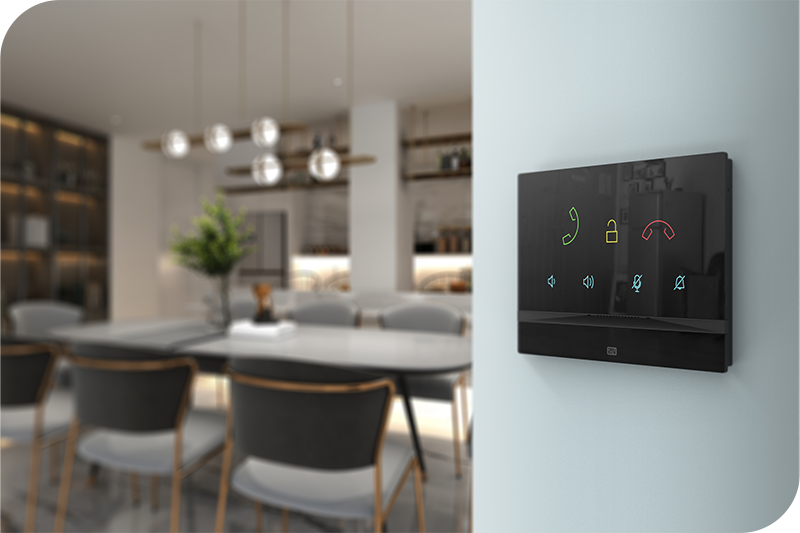The History – and Future - of Indoor Stations in Access Control Systems
 Camilla Ashdown, 12. 03. 2024 | 5 min read
Camilla Ashdown, 12. 03. 2024 | 5 min read
Indoor stations, also known as answering units, have come a long way since their humble beginnings as simple answering devices. The best models today offer state-of-the-art features – but why did the need for extra capability arise, and what lies ahead? Let's take a look

The Early Days: Speaking Tubes and Telephones
It goes without saying that the very first indoor station was not, in fact, an indoor station – the door would ring (or someone would knock) and that would be the ‘intercom call’ of today.
But, eventually, the need for remote communication arose – and not just from the front door to the living room. The invention of the telephone in 1876 revolutionised communication, allowing users to talk to each other over long distances using electric signals.
Building on this, the first attempts at devices that can be seen to resemble the indoor stations of today date back to the 19th century, when engineers built speaking tubes to carry voices between two people in the same building. These tubes were simple pipes that connected different rooms or floors, and users had to blow into them to signal the other party before speaking. Some systems were elaborate enough to connect up to 25 different rooms!
However, even at this time, the concept of being able to open a door whilst in another room was practically unheard of. It wasn’t until the early 20th century, when electric strikes and early versions of intercoms started to emerge, that doors could be unlocked remotely – in this instance by applying an electric current.
The Rise of Intercoms: A New Call to Answer
By the mid-20th century, the world changed – ‘modern’ apartment living was fast becoming the norm in cities and towns growing in population and wealth.
In the 1950s, intercoms took on a new role as electronic doormen for apartment buildings. To gain entrance through the electronically locked front door, visitors had to buzz the resident they wanted to see, then talk to them via a simple audio unit and identify themselves when they replied. If the resident decided to grant access, they could hit a button that opened the front door.
However, this system relied on audio-only communication, which could be unreliable or unsafe in some situations. For example, residents could not verify the identity of the visitors by sight or see if they were accompanied by someone else. Moreover, visitors could pretend to be someone else or use a fake voice to trick the residents.
To overcome these challenges, manufacturers began to offer door access control systems that incorporated video as well as audio to identify visitors in 1984. These systems added a black-and-white camera to the intercom at the front entrance and installed a video screen inside the buildings on separate units, creating the first video indoor station and video door entry system.
These first intercom and indoor station systems relied on analogue technology – which is still used today in residential buildings and small businesses. They are simple systems that facilitate two-way communication within a building or a limited area through a straightforward two-wire configuration.
They consist of master stations with call initiation capabilities and substations for individual locations, and systems were simple to install - employing a single pair of wires for both power supply and communication signals.
While their ease of installation and maintenance is a notable advantage, the features of analogue systems are often basic (communication + door opening) and the quality of the audio (or video) is unreliable.
The Modern Era of Indoor Stations: IP and Mobile Apps
Today, we have sophisticated door access control systems.
The advent of digital technology and the Internet in the late 20th and early 21st centuries brought new possibilities and challenges for intercom systems. On one hand, digital technology improved the quality, functionality, and scalability of IP intercoms and indoor stations, as it eliminated the constraints of analogue technology. On the other hand, the Internet introduced new threats and risks, such as cyberattacks, data breaches, and privacy violations.
To address these issues, manufacturers developed IP-based systems, which use the Internet Protocol (IP) to transmit data over a network. IP indoor stations offer several advantages over traditional ones, such as:
- Higher audio and video quality, as digital signals are less prone to distortion and interference than analogue signals
- More features and functions, such as:
Integration with security cameras for home monitoring
Integration with home automation platforms which allows the indoor station to become not only an answering unit but a device to control the entire home – air conditioning, blinds, lighting, and so on
Video or audio messaging to allow residents to see who tried to visit them whilst they were out
- Greater flexibility and scalability, as IP devices can be easily added, removed, or relocated within a network without requiring additional wiring or hardware
- Lower installation and maintenance costs, as IP intercoms use existing network infrastructure and can be managed centrally – or even remotely using a cloud platform
One of the most innovative features of IP intercom systems is the ability to use mobile apps to communicate with visitors and control access. This has changed the indoor station from a physical answering device to a tool on a mobile phone.
Access apps allow users to receive calls, see live video streams from IP video intercoms or IP security cameras, and open doors from their smartphones or tablets, regardless of their location. This adds convenience, security, and efficiency for both users and visitors, as they can communicate and grant access without being physically present at the door or the indoor station.
It should be noted, however, that mobile apps are not a complete replacement for indoor stations: not all residents or receptionists can (or will want to) use their mobile phones to answer doors, and a high-quality hardware unit inside the apartment or at the reception remains a vital part of a door access control system.
The Future: What's Next?
As technology continues to advance, door access control systems will likely incorporate more features and capabilities, such as:
- Artificial intelligence and machine learning, which can enhance the performance, reliability, and security of devices, as well as provide personalized and proactive services for users and visitors
- Increased use of cloud computing and edge computing, which can improve the scalability, efficiency, and flexibility of door access control systems, as well as reduce the dependence on local hardware and software
- Augmented reality and virtual reality, which can create immersive and interactive experiences for users and visitors, as well as provide additional information and guidance. We could see indoor station functions become incorporated into technology such as AR glasses!
So, next time you open your door – remember that indoor stations are not just devices that allow users to talk to visitors. They have evolved steadily into devices that enhance security, convenience, and efficiency and are devices that reflect the past, present, and future of door access control system technology.